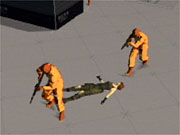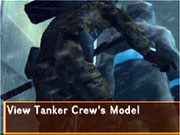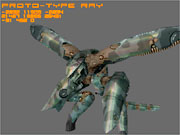The Document of Metal Gear Solid 2 Preview
Document is an interactive "making of" guide to one of last year's greatest games. Read up on what you can expect to find when it ships.
See it in Action!
When Metal Gear Solid 2: Substance was announced earlier this year, fans of Hideo Kojima's memorable character-driven and stealth-inspired action game undoubtedly rejoiced at having the chance to relive the intense sequences from Metal Gear Solid 2: Sons of Liberty in the form of literally hundreds of new missions involving everyone's favorite commando, Solid Snake, as well as the newbie Raiden. But while Substance is very much still on schedule to release later this year, the game will be available strictly for the Xbox--at least until 2003 rolls around. PlayStation 2 (and PC) owners hoping to get an additional dose of Metal Gear Solid 2 will have to wait until the early months of next year for the release of the subsequent versions of Substance. That doesn't mean, however, that Xbox owners will be the only ones getting a new Metal Gear Solid game this year. To appease PS2 fans who'll have to wait an extra few months before the release of Substance, Konami will be releasing The Document of Metal Gear Solid 2, a PlayStation 2-only interactive documentary on the making of Metal Gear Solid 2, in the coming weeks. We recently had the chance to peruse the many different sections of this game, and being the Metal Gear fanatics that we are, we were pleased with what we saw.

The Document of Metal Gear Solid 2 is notable for the fact that it isn't so much a game in the traditional sense as it is a reference guide on all things Metal Gear. In fact, it's not really a game at all--there's little gameplay to speak of, and most of the content it does have isn't all that interactive, either. Document is best likened to a special features section of a typical DVD, as it's broken down into several distinct parts, each of which contains video, photos, and design notes on that specific element of the game's design. In a nutshell, Document breaks down the development of Metal Gear Solid 2: Sons of Liberty into eight individual stages--character design, mechanical design, level design, cutscenes, programming, sound, game design, and script--and also includes four additional sections that further chronicle the development process of this game. These four include a timeline of the game's entire development process, a detailed staff list of the design team, additional footage of the game in its early stages and of the research that went into making the game, and pictures of the numerous merchandise that this single game spawned after and before its release. But Document isn't all reading material--the game will also have five VR missions that, as either Snake or Raiden, will test your skills in stealth, combat, and weapons handling, though the appeal of Document will clearly be in its reference material. Let's take a closer look at these components.

Characters: The first section of Document's reference guide examines all of the characters that took part in the story of Metal Gear Solid 2, from the leading men to the bit roles. Here you'll find the actual in-game 3D models that were used in MGS2, as well as numerous hand-drawn sketches for each of these characters. Included in this section are 3D models and drawings for characters like Solid Snake, Iroquois Pliskin, Raiden, Otacon, Emma, Rose, Colonel, Ninja, Olga, Solidus, Fortune, Fatman, Sergei, Revolver Ocelot, and Scott Dolph, as well as for the Navy SEALs, Richard Ames, Peter Stillman, and President Johnson. There are also 12 different models for the hostages that were trapped on Big Shell, five different types of NYPD officers that were seen in the closing moments of the game, seven different US Marines from the tanker episode, and eight different Gurlukovich soldiers, including the mysterious Arsenal Tengus. You'll even find a cel-shaded version of Mei Ling that was used by Hideo Kojima and Yoji Shinkawa to demonstrate 3D modeling to students at Konami's training facility, as well as interesting sketches of some unused Metal Gear Solid 2 characters like Oldman, Chinaman, and a female named Max.
Using the PlayStation 2 controller's L2 shoulder button, you can bring up an options menu that will let you adjust the background color, ambient light color, texture color, and the location of the light source to your liking. Some 3D models will also have the option of adding various items to their person. For instance, you can add a cigarette, a pair of sunglasses, and an M4A1 assault rifle to Pliskin's character. Additionally, Document uses a unique hyperlink mechanic that, by using the R2 button, will let you quickly jump to any material that's associated with whatever you're looking at. When looking at the 3D model of Olga, for example, you can quickly jump to sketches of Olga by selecting them from the R2 button, instead of canceling out of your current menu, going back to the main menu interface, and selecting sketches from that screen. It's a simple yet innovative addition that will make surfing through the rest of Document's sections a breeze.
The Making of a Classic
Mechanics: Similar in functionality to Document's characters section, the mechanics portion of the game contains sketches and 3D models of all the mechanical objects that appeared throughout the course of Metal Gear Solid 2: Sons of Liberty. As you'd probably expect, included here are images and models of Metal Gear Ray, the massive Arsenal Gear, the Kasatka helicopter, the Harrier, the Cypher, the Navy HH-60H Sea Hawk chopper, and even the game's many, many security cameras. Interestingly enough, you'll also find 3D models of Metal Gear Rex, a Hind-D helicopter, and an M1A1 Abrams tank, all of which are from the original Metal Gear Solid, but all of which have been rendered using high-res textures and lots of polygons, courtesy of the MGS2 engine. You'll even get to take a look at an impressive V-22 Osprey, a VTOL aircraft that was supposedly originally intended for use in Metal Gear Solid 2, though it never made the final cut. In fact, as you sort through the rest of Document's sections, you'll stumble onto a lot of content that was removed from Metal Gear Solid 2.

Background: This section of The Document of Metal Gear Solid 2 contains 3D models and drawings of the game's 54 locations. These areas are split up into the three distinct episodes of MGS2. Specifically, there are 16 locations from the tanker sequence, 28 from the plant sequence, and 10 from the Arsenal Gear/NYC setting. Here, you can rotate around and zoom in on locations like the George Washington Bridge, the Verrazano Narrows Bridge, the roof of the Federal Building, and the various rooms and corridors from the tanker and Big Shell. Also available in this section of Document are nine areas that were ultimately not used in Metal Gear Solid 2, including early models of Big Shell and the aft deck of the tanker, as well as the overhead view of downtown Manhattan after Arsenal Gear's crash landing. That scene was removed shortly after the event of September 11, 2001, because it clearly depicts the World Trade Center overlooking a destroyed metropolitan area--Konami felt that keeping this scene in Metal Gear Solid 2 would be inappropriate. Just like in the mechanics and characters sections of Document, you can jump to related sketches of these levels using the R2 button, and you can also adjust the fog density and lighting using L2.
Polygon demos: Perhaps the most appealing aspect of Document is found in this section, unintuitively referred to as "polygon demos" within the game. Here, you can view more than 130 in-game cutscenes from Metal Gear Solid 2. The actual count is 27 from the tanker episode and 108 from the plant, Arsenal, and New York City levels. These movies have no audio, but what makes them so appealing is that you can pause them whenever you want and, using the controller's analog sticks, move around the entire 3D scene in real time. In effect, you can become the director by changing the camera position to your liking and playing select scenes from a different perspective. That, coupled with the ability to move a particular scene forward frame by frame, means you can spend hours reexperiencing the same cutscene in slow motion or from new angles. Particularly interesting cutscenes include the initial encounter between Olga and Snake aboard the tanker, where, using the game's slow-motion feature, you can actually see Olga's bullet graze Snake's head. What's more, by using Document's hyperlink system (activated by pressing the R2 button), you can jump to any sketch or 3D model of the levels, characters, and mechanical objects depicted in any given cutscene.

Program: The fifth stage of Metal Gear Solid 2's development that Document chronicles is the programming. Called simply "program," this section has 13 different sections that contain pages upon pages of complicated notes regarding things like data management, collision detection, enemy AI, and level-loading. These detailed notes talk about how various issues were approached by the game's programmers and how code-related problems were solved. One entry discusses how the Emotion engine's 32MB of system memory were allocated on a per-level basis. For those interested, it was 4MB for the "program domain," 7MB for permanent data, 15MB for model data, 4MB for image drawing, and 512Kb for streaming, and the remaining 512Kb was for miscellaneous data.
Sound: As you can probably guess by its name, the sound portion of Document will let you listen to Metal Gear Solid 2's soundtrack, which is composed of 29 different tunes, including those from the many boss fights. Most of these tracks have five different patterns that, in the game, dynamically change according to your predicament. Metal Gear Solid 2 veterans know these five states to be sneaking, detection, alert, evasion, and caution. Within this portion of Document, an intuitive counterclockwise display lets you easily cycle through these five different modes instantly while listening to most songs.
Important Milestones
Game plan: This section would have undoubtedly been the most interesting to US fans of Kojima's work, as it contains long PDF-style design documents written by Kojima himself. These illustrated notes discuss high-level concepts for Metal Gear Solid 2 like the inclusion of role-playing game elements, the plot, and the move to a more powerful architecture, as well as low-level topics like instructions about where soldiers should be placed in a given level. Unfortunately for the majority of US gamers, Kojima's first language isn't English, and all of these notes and diagrams are written completely in Japanese. Still, most fans will surely enjoy flipping through copies of the game's actual design document.

Script: Unlike the design document for Metal Gear Solid 2, the game's script is completely in English. Here, you'll find literally hundreds of pages of script for the game's 36 individual scenes, each of which is made up of thousands of words that describe the setting, set the stage, and, of course, include the actual dialogue for all of the characters. It's interesting to take note of the tone that the designers at Konami were attempting to set during some scenes as compared to what was actually relayed in the actual game. For instance, the script for one of the final scenes in the game reads: "Solidus falls off of the roof, covered with blood. He expires holding onto the statues of George Washington. The irony here is Solidus' unfulfilled ambition to be the President and the architect of another declaration of independence." Few people would have made this connection the first time through Metal Gear Solid 2, but the designers' goals for the players are made crystal clear in this script.
Staff: The last four sections of Document act as a supplement to the first eight parts in that they focus on the people and events around Metal Gear Solid 2 instead of the game itself. The staff section shows the hierarchy of the design team responsible for MGS2 at Konami Computer Entertainment Japan, and it breaks down the game's development processes into three main components: programming, design, and sound. Each of these components is further broken down into things like enemy AI for programming, motion-capture for design, and sound effects under sound. You can highlight and click any of these individual components, and you'll be taken to a list of those staff members who were involved in overseeing that particular element. Most of those names will link to an additional menu that shows that person's bio, including, in true Metal Gear Solid fashion, blood type.
Chronicle: Chronicle is the official timeline of Metal Gear Solid 2's three-and-a-half-year development cycle. From the July 30, 1998, party for completing the original Metal Gear Solid, to March 8, 2002, when the European version of Metal Gear Solid 2: Sons of Liberty was released, every single milestone in the game's development is chronicled here. Even marriages and childbirths for the team are noted here. Other notable entries include the October 6, 1998, meeting with Sony to discuss the technical aspects of the PlayStation 2, the May 2000 unveiling of Metal Gear Solid 2 in Los Angeles, and the September 28, 2001, completion of the US master ROM of MGS2. Additionally, many of these dates are also hyperlinked, using the R2 button, to applicable items, movies, or still pictures.

Special footage: While some of the videos contained within the special footage section of Document have been seen before (who can forget the E3 2000 trailer?), many will be seen for the first time. Included in this section are 10 promotional cutscenes, complete with sound and dialogue, as well as nine full-motion videos of motion-capture sessions and other important parts of the game's design. Cutscenes of note include the very first video used to pitch Metal Gear Solid 2--known internally as MGSIII--to Konami executives. This video is a very rough version of the E3 2000 trailer, and it lacks the overall polish found in the final game. The scene is narrated by Scott Dolph, Kojima's personal assistant, who tries valiantly to do his best Snake impression. Other noteworthy videos include the May 1999 research trip to New York City and the lecture on squad tactics by the game's military advisor, Motosada Mori. There's even a home video of Hideo Kojima receiving an official fax from Sony notifying his team that the release candidate build of Metal Gear Solid 2 has been approved for gold mastering--champagne bottles appear out of nowhere seconds later.
Items: The 12th and last section you'll find in The Document of Metal Gear Solid 2 contains photographs of the countless books, magazine covers, action figures, collectible figurines, soundtracks, packages, and other promotional items that were released before and after the game's release. Included in this section are pictures of some Japan-, Europe-, and press-only items as well--things that a US fan of the Metal Gear Series will thoroughly enjoy examining.
Aside from giving fans of this venerable series a reference of everything that went into making one of last year's greatest games, The Document of Metal Gear Solid 2 is also aimed at giving budding designers some insight into what is involved in making a game. Document's eight distinct sections on MGS2's design clearly illustrate the intricate pieces that were involved in this project, and the five VR missions represent how these pieces should ideally come together. Of course, for the rest of us, they're also just a lot of fun to play. No matter which of these categories you fall into, Document is certainly a must-have for followers of Kojima's work. The Document of Metal Gear Solid 2 will ship before the end of September for $19.
Got a news tip or want to contact us directly? Email news@gamespot.com
Join the conversation